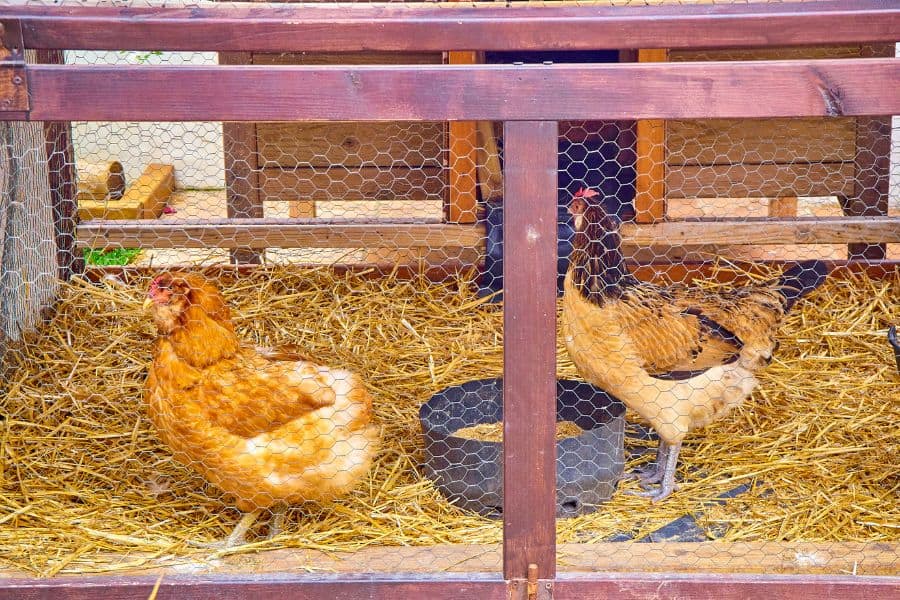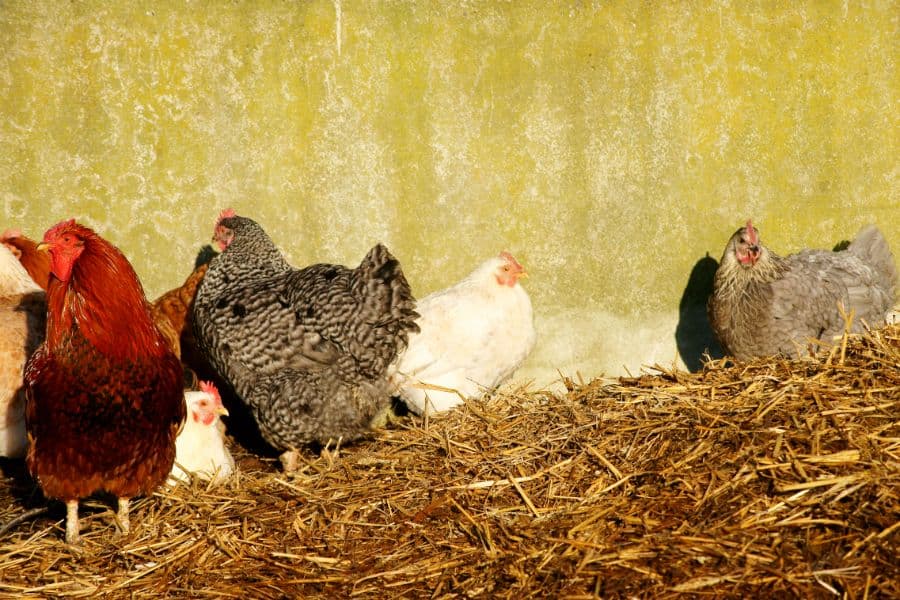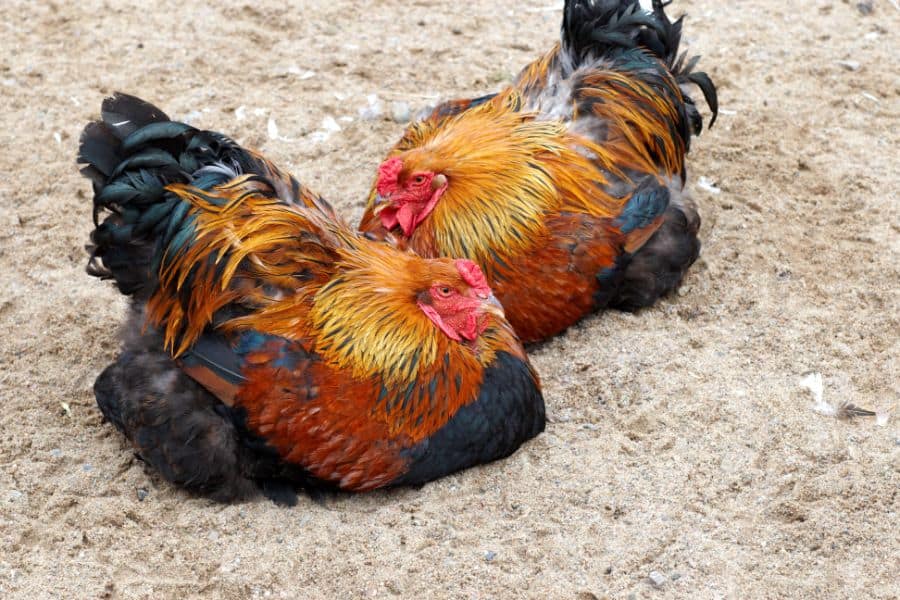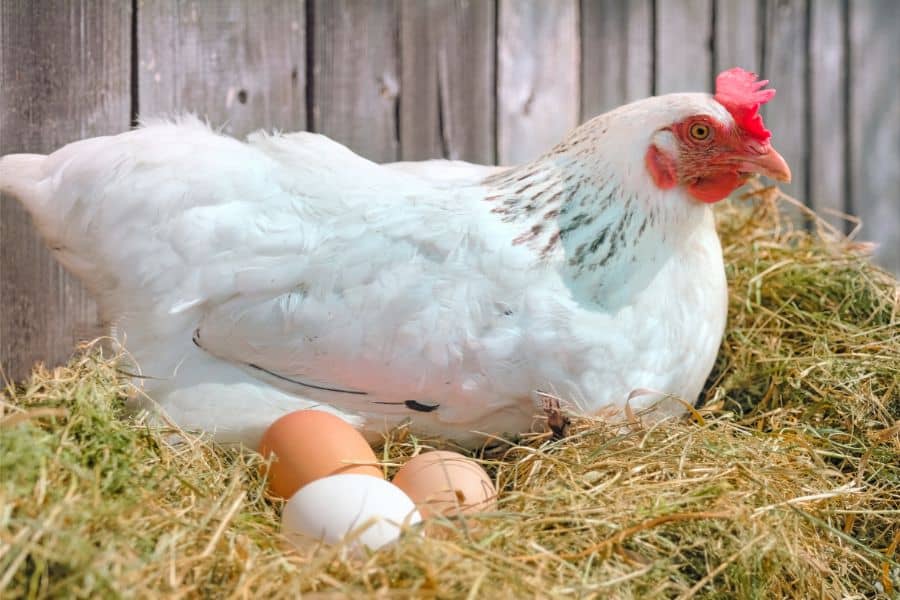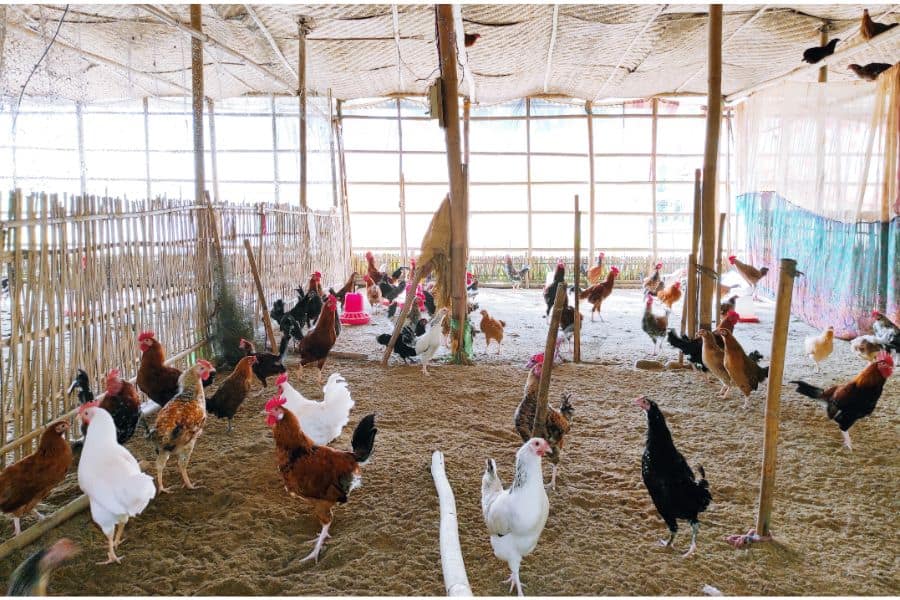Choosing the best chicken bedding or litter remains a highly debated topic in poultry keeping.
Most chicken farmers stand firmly behind their top choices. And while there are various chicken bedding options, you must get the facts before settling for a specific material.
Besides comfort, good chicken bedding should also control odor, reduce moisture, and offer a safe place for laying eggs. The last thing you want is for your feathery friends to snuggle up in a damp, stinking coop.
Without a doubt, chicken bedding can be a farmer’s best friend or enemy. If you make the right selection, your flock will thank you. If you get it wrong, prepare yourself to deal with harmful bacteria, parasites, and mold.
So, what is the best bedding for chicken?
Worry not! Our guide discusses the various chicken bedding options available to poultry farmers so you can make an informed decision.
It doesn’t stop there:
This piece also highlights the important factors to consider when selecting the most effective chicken bedding.
Do you want to keep your chicken healthy and happy? Continue reading below.
Understanding Your Chickens Needs
A clean and comfortable chicken coop boosts your chicken’s health and overall well-being. But this only rings true if you use the appropriate bedding material.
“Appropriate” here refers to chicken bedding options with the following qualities:
Provide Good Cushion for Eggs, Chicks, and Chickens
You probably know chickens love to jump up and down from their roosting bars. So, having chicken litter with cushioning properties can help reduce the chances of injury.
Comfortable bedding, especially in your birds’ nesting boxes can encourage laying. It also offers protection to delicate eggs and hatched chicks.
High Moisture Absorption and Release Rate
Did you know chicken waste contains 85% water?
Chicken droppings include feces and urine.
Yes! Chickens also pee. But unlike mammals, chickens don’t produce a stream of liquid since they have no bladder. Instead, their urine gets excreted as urates–the white stuff you often see on chicken poop.
When combined, the poop and urine can increase the moisture content in the coop. If you’re using chicken bedding with poor water absorption properties, the excess moisture can prove detrimental to your birds. How?
Well, moist bedding creates an ideal environment for harmful pathogens and bacteria to thrive, leading to diseases. Not to mention the foul odor that will be coming out of your chicken house.
High moisture levels in your chicken coop also promote mold growth, which releases spores, toxic to your birds and even you.
To avoid these, select high-quality chicken bedding that absorbs and releases moisture through evaporation to stay dry.
Offers Good Insulation
An ideal chicken bedding should have low thermal conductivity to provide insulation and retain warmth. Also, the material you choose should remain cool in the hot summer months.
Top Beddings Options for Chickens
With so many options available, finding chicken bedding or litter that can meet your needs can be difficult.
Each type of litter comes with its benefits and drawbacks, which you must familiarize yourself with before making a selection.
Luckily, this section explores 6 best chicken bedding, including their unique advantages and disadvantages. Let’s check them out.
1. Straw
Straw bedding is made from dried stalks of wheat, oats, and barley. It is one of the most popular and traditional forms of chicken bedding used by chicken keepers and enthusiasts.
Its natural feel, unique smell, and amazing composting ability make it a superb choice for litter.
Pros of Straws Bedding
- An excellent insulator, making it great for use during the cold winter climate
- Easily accessible and easy to maintain
- Super soft, keeping your chicken coop cozy for your flock
- Composts well with droppings
- Economical
Cons of Straws Bedding
- Lacks absorption and hence requires frequent changing
- Prone to mold growth since it has poor absorption and moisture release
- Low odor prevention because it’s not absorbent
Preparing Straw Bedding
When preparing straw bedding, remove all the seeds, chop them into small pieces, and let them dry to avoid molds in your coop.
Put the straw on the coop floor till it’s a few inches thick. Lastly, fluff it up while tossing it down and ensure it doesn’t clump together.
2. Wood Shavings
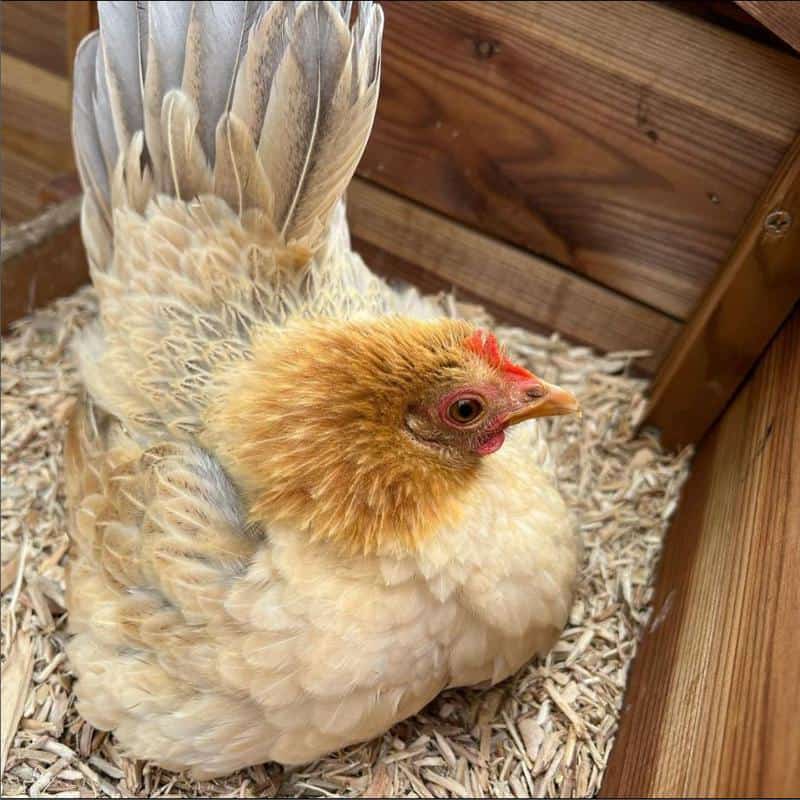
Wood shavings are another popular material for making chicken bedding. It’s a low-cost alternative and offers impressive absorption and insulating capabilities.
As the name implies, this material comes from different woods, but mostly white, soft pinewood. Some chicken owners also use wood shaving from cider, but we recommend against it. Why?
Cedar shavings contain Plicatic acid, which can cause a wide range of respiratory issues in chickens and damage their livers. Keep in mind dust from cedar wood shaving also has a carcinogenic effect on animals and humans.
Wood shavings bedding needs regular cleaning to prevent over-saturation. Furthermore, stir the shavings regularly to mix the droppings.
You can buy pine shaving at your local supply store or nearby wood processing company.
Pros of Pine Shavings
- Dries fast and doesn’t break down easily
- Can be used for manure and mulching
- Comfortable for chickens
- Eliminates odor efficiently
- Inexpensive and easy to store
Cons of Pine Shavings
- Medium quality litter
- Strongly scented
- May harbor bacteria
3. Sand
Poultry farmers have varying opinions on the use of sand as chicken bedding. Some believe sand is the best litter and anything else is crap. Others believe this material makes the worst bedding, and you’ll be a monster if you use it for your birds.
So, what’s the truth?
Let’s start with fine-grained sand, like beach sand.
This material makes the worst litter because your birds can eat some of the sand.
Trust us! You don’t want that. If your girls eat too much sand, their crops might become easily compacted, leading to digestive problems or even death.
Fine-grained sand (play sand) can also cause long-term respiratory issues in your birds, like Silicosis or silicate pneumoconiosis.
What of medium or coarse-grained sand?
It’s absolutely the best chicken bedding material since it’s natural, stays dry, and doesn’t decompose.
Pros of Sand Bedding
- It absorbs moisture from the chicken poop to keep the coop dry
- The bedding is gentle on the feet, making it great for chicks
- It’s economical in the long run since it does not require frequent replacement like straw and wood shavings
- Sand doubles as an excellent substrate for dust baths
- Provides insulation in the summer
- It’s flame resistant
Cons of Sand Bedding
- It can be dusty with extended use
- Can be expensive upfront
- Sand is heavy
4. Hay
Hay is the more fibrous and dried-up cousin of grass. And while it is closely related to straw, straw is a by-product of grains, whereas hay is a crop.
If you have a ranch or farm, chances are you store hay for horses. Hay does not soil fast like grass; it’s absorbent and covers the feces smell pretty well.
However, it’s not without some drawbacks. For instance, hay can develop mold spores that cause respiratory issues in your chickens. Also, it creates the perfect breeding ground for mites, which can harm your chicken
5. Pine Pellets
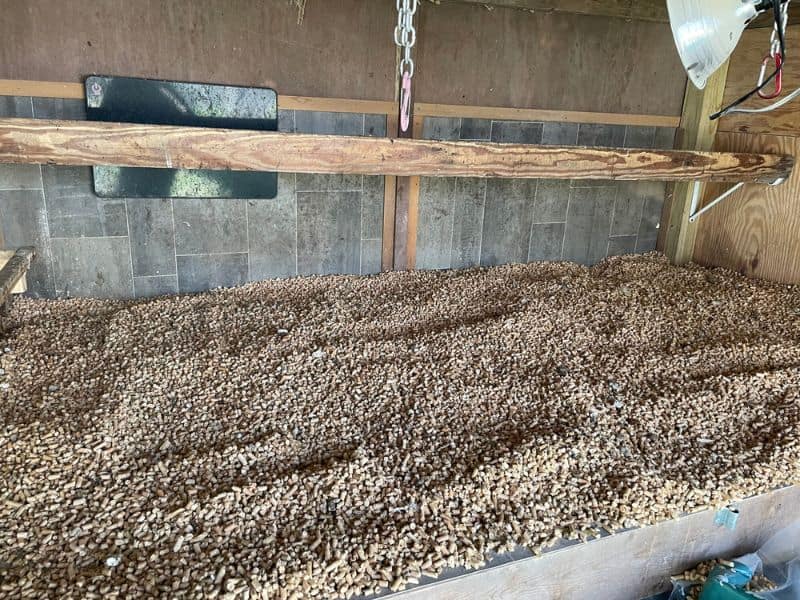
Some pine wood processing companies convert all their waste, like sawdust, wood chips, and wood shavings, into pellets.
These pine pellets make good chicken litter because they can absorb moisture 4 times their weight and are easy to clean. They are also environmentally friendly and smell good.
To use pine pellets as chicken beddings, just spread them on the coop and sprinkle water to break them apart. This will make them fluffy, soft, and more comfortable.
6. Hemp Bedding
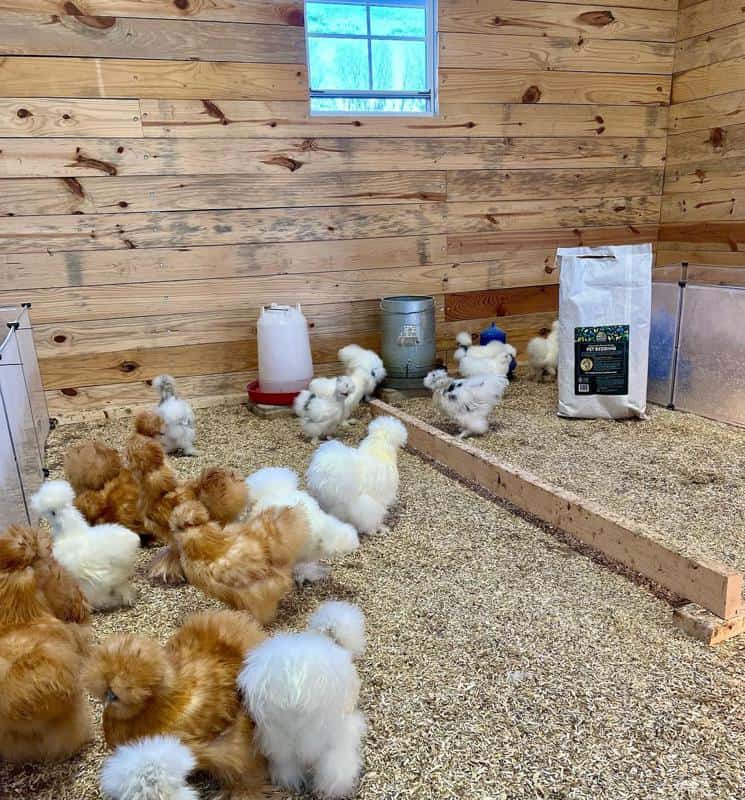
Hemp is a unique material that provides an eco-friendly and natural alternative to straw. It’s a sustainable chicken bedding alternative that requires little water to grow. Besides, it’s less harmful to the environment.
This 100% organic plant fiber is super absorbent, long-lasting, and leaves the coop dry and smelling fresh.
Factors to Consider When Choosing Beddings for Your Chickens
- Cost-effectiveness: Budget constraint remains a significant consideration when choosing chicken bedding. Fortunately, there are various cost-effective alternatives out there. For example, straws, wood shaving, and pine pellets are usually inexpensive and sometimes free.
- Availability: There’s no point in establishing the ideal bedding only to discover it’s only available thousands of miles away. Thus, choose a readily available material.
- Absorbency and moisture control: No poultry farmers want their birds to sleep in a smelly damp environment. So, opt for litter options with high moisture absorption to maintain a dry and comfortable coop for your flock, especially in winter.
- Respiratory Health: Some bedding materials, like wood shavings, can generate dust, leading to eye infections and respiratory problems. Thus, choosing dust-free options such as sand or frequently changing the bedding is vital for the chicken’s health.
- Ease of cleaning and maintenance: Easy to clean-and low-maintenance chicken bedding is worth considering. Moving bedding into and out of the coop is backbreaking. Therefore, choose a chicken bedding that’s lightweight and easy to maintain can to save time and energy.
Bedding Management Practices
Good chicken bedding management practices positively affect poultry welfare, production performance, and disease prevention.
Initial Setup
Although beddings function effectively on an earthen floor, you can use a concrete floor for perfect disinfection before each replacement.
Spread the bedding material at least 5 cm on the floor. Initially, have about 3-5 inches’ depth of the bedding; as it breaks down, add more to a depth of 8-12 inches. Ensure to remove wet litter material before adding fresh bedding.
Prepare attractive nesting boxes and place them inside the coop in a safe, private, darkened spot. If you place it in a busy and noisy area, the hens won’t use it.
Regular Cleaning Routine
You should rake the chicken bedding at least once a week in summer and twice a week in winter. Also, constantly remove soiled beddings and aerate the compacted and humid coop areas.
Bedding Replacement
How often you replace bedding depends on the material you use. Nevertheless, replace the bedding immediately if you notice the following signs:
- Unpleasant smell
- Cobwebs
- Dust
- Dirty beddings
- Built up feces
- Dirty nesting boxes
Common bedding replacement methods include partial and complete. Partial replacement includes removing caked material, disinfecting the coop, and adding new material.
In contrast, complete replacement requires completely cleaning the coop, disinfecting it, and putting in new bedding material.
Seasonal Considerations
Good chicken bedding should have a low thermal conductivity to stay warm in winter and cool in summer.
Preparing for different seasons should be easy when perfect coop management practices for waste handling and ventilation are in effect.
Dealing With Chicken Bedding Challenges
Ammonia Build-up
Ammonia in chicken coops results from breakdown of fecal material by bacteria. Its buildup in the chicken coop could prove harmful to your birds and people who venture into the structure.
The ammonia gas formed can harm chickens and cause breathing problems, inflammation, and tracheal irritation.
The best way to reduce ammonia generation is through partial cleaning (or frequent stirring) and adjusting the ventilation rate.
Fungal and Bacterial Growth
After providing your chicken with a clean environment, routine preventive measures should be adopted. These measures include:
- Identifying and treating sick chicks and chicken
- Vaccination
- Parasite control
Pest Infestation
Rodents, snakes, termites, lice, flies, and fleas are the main pests you are likely to encounter in chicken beddings. These pests cause discomfort and may lead to reduced egg production. Therefore, keep your coop free from weeds and bushes that harbor pests.
You can also sprinkle some engine oil around the base of the chicken coop to keep termites away. Additionally, block all crevices and holes where pests can easily access the coop.
Also Read:
Final Thoughts
Before you can select the best bedding for your chickens, it’s crucial to consider factors like ease of maintenance and affordability.
Remember, your selection will considerably influence the coop’s cleanliness and maintenance efforts, plus your flock’s health.
As you can see, every chicken bedding option has its advantage and disadvantages. So, settle for the litter that will make your life easier while keeping your feathery pals healthy and happy!
